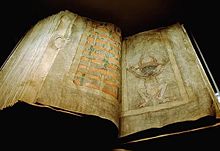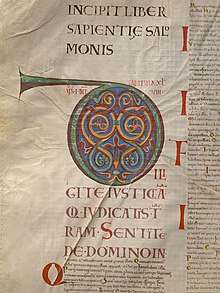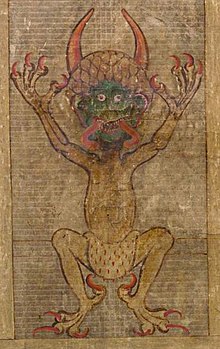Codex Gigas: Difference between revisions
| Line 34: | Line 34: | ||
== See also == |
== See also == |
||
* [[List of New Testament Latin manuscripts]] |
* [[List of New Testament Latin manuscripts]] |
||
== References == |
== References == |
||
Revision as of 23:45, 14 February 2010

The Codex Gigas (English: Giant Book) is the largest extant medieval manuscript in the world.[1] It is thought to have been created in the early 13th century in the Benedictine monastery of Podlažice in Bohemia (modern Czech Republic). During the Thirty Years' War in 1648, the entire collection was stolen by the Swedish army as plunder and now it is preserved at the National Library of Sweden in Stockholm.[1] It is also known as the Devil's Bible because of a large illustration of the devil on the inside and the legend surrounding its creation.
Appearance

The codex is contained in a wooden folder, covered with leather and ornamented with metal. At 92 cm (36.2in.) tall, 50 cm (19.7in.) wide and 22 cm (8.6in.) thick it is the largest known medieval manuscript.[2] It initially contained 320 vellum sheets, though eight of these were subsequently removed.[3] It is unknown who removed the pages or for what purpose but it seems likely that they contained the monastic rules of the Benedictines. The codex weighs nearly 75 kg (165 lbs.) . The Codex Gigas has 310 parchment leaves, perhaps made from calfskins.
History
The codex was believed to be created by Herman the Recluse in the Benedictine monastery of Podlažice near Chrudim, which was destroyed during the 15th century. Records in the codex end in the year 1229. The codex was later pledged to the Cistercians Sedlec monastery and then bought by the Benedictine monastery in Břevnov. From 1477-1593 it was kept in the library of a monastery in Broumov until it was taken to Prague in 1594 to form a part of the collections of Rudolf II.
At the end of the Thirty Years' War in the year 1648, the entire collection was stolen by the Swedish army as plunder. From 1649 to 2007 the manuscript was kept in the Swedish Royal Library in Stockholm. The site of its creation is marked by a maquette in the town museum of Chrast.
On September 24, 2007, after 359 years, Codex Gigas returned to Prague on loan from Sweden until January 2008 (on display previously at the Czech National Library).[4][5][6]
Content
The Codex includes the entire Latin Vulgate version of the Bible, except for the books of Acts and Revelation, which are from a pre-Vulgate version. Also included are Isidore of Seville's encyclopedia Etymologiae, Josephus' Antiquities of the Jews, Cosmas of Prague's Chronicle of Bohemia, various tractates (from history, etymology and physiology), a calendar with necrologium, a list of brothers in Podlažice monastery, magic formulae and other local records. The entire document is written in Latin.

The manuscript includes illuminations in red, blue, yellow, green and gold. Capital letters are elaborately illuminated, frequently across the entire page. The codex has a unified look as the nature of the writing is unchanged throughout, showing no signs of age, disease or mood on the part of the scribe. This may have led to the belief that the whole book was written in a very short time (see Legend). But scientists are starting to believe and research the theory that it took over 20 years to complete.
Page 577[7], otherwise empty, includes a unique picture of the devil, about 50 cm tall. Several pages before this are written on a blackening vellum and have a very gloomy character, somewhat different from the rest of the codex. The reason for the different coloring is that when vellum is exposed to light it "tans", as vellum is made from animal skins, so over the centuries the pages that were exposed will have a darker color to them.
Legend
This article needs additional citations for verification. (April 2009) |
According to legend the scribe was a monk who broke his monastic vows and was sentenced to be walled up alive. In order to forbear this harsh penalty he promised to create in one single night a book to glorify the monastery forever, including all human knowledge. Near midnight he became sure that he could not complete this task alone, so he made a special prayer, not addressed to God but to the fallen archangel Satan, asking him to help him finish the book in exchange for his soul. The devil completed the manuscript and the monk added the devil's picture out of gratitude for his aid.[1][8]
It is also speculated that the inscription of various exorcism spells is the monk trying to exorcise the devil out by himself. (Similar to monks who sinned, and were punished by having them write out the Bible by hand, as it was believed that God's goodness would be transferred to them by doing that.)
Despite this legend, the codex was not forbidden by the Inquisition, and was studied by many scholars.
Modern studies in linguistics suggests the monk was in total solitary confinement, possibly self imposed. In tests to recreate the work, it is estimated to have taken 20 or more years to have written the work.
See also
References
- ^ a b c Codex Gigas - Kungl. biblioteket, Stockholm
- ^ Boldan, Kamil (2007). The Devil’s Bible - Codex Gigas. The Secrets of the World’s Largest Book. NKP. p. 15. ISBN 978-80-7050-532-8.
{{cite book}}: Unknown parameter|coauthors=ignored (|author=suggested) (help) - ^ Boldan, Kamil (2007). The Devil’s Bible - Codex Gigas. The Secrets of the World’s Largest Book. NKP. p. 17. ISBN 978-80-7050-532-8.
{{cite book}}: Unknown parameter|coauthors=ignored (|author=suggested) (help) - ^ Canadian Press, Return of the COdex Gigas to Prague draws crowds of curious Czechs
- ^ Raising the devil - A legendary work returns to Prague
- ^ Borrowing the Devil's Bible
- ^ http://www.wdl.org/en/item/3042/pages.html#volume/1/page/577
- ^ "Satanic Inspiration", The Prague Post Online, September 12, 2007.
Further reading
- Bártl, S., Kostelecký, J.: Ďáblova bible. Tajemství největší knihy světa, Paseka, 1993. ISBN 80-85192-64-0
- Codex Gigas in the European Library: treasure of national library of Sweden
External links
- Codex Gigas — Official Codex Gigas site at the National Library of Sweden.
- World Digital Library — High quality version of book at WDL
- National Geographic
- Browse Codex Gigas — Browse the complete Codex Gigas in high resolution.
- Enormous interest in the Devil’s Bible! - News story at Czech.cz, official portal of the Czech Republic
- The Manuscriptorium A Czech language website with a high resolution digital copy of the manuscript
